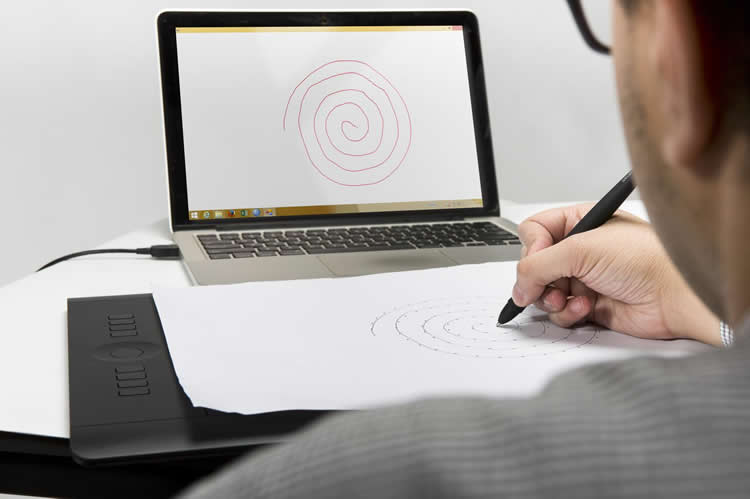Summary: Researchers have developed software capable of measuring writing speed and the pressure of a pen on a page. Asking volunteers to draw spirals, and using the new technology to analyse both speed and pen pressure, researchers were able to detect who had Parkinson’s, as well as the severity of the disease.
Source: Frontiers.
Researchers combined measurements of drawing speed and pen pressure to diagnose Parkinson’s disease severity.
Researchers in Australia asked volunteers to draw a spiral on a sheet of paper. By analyzing how long it took them to draw the spiral and how hard they pressed on the paper with the pen, the team could not only tell which volunteers had Parkinson’s disease, they could also tell how severe it was.
Parkinson’s disease is a neurodegenerative disorder that causes shaking, muscle rigidity and difficulty with walking. Many treatment options for Parkinson’s are only effective when doctors diagnose the disease early, and when symptoms are very noticeable it may be too late. It’s also important for doctors to be able to tell how severe the disease is, to make the right treatment decisions, and to follow-up the progression of symptoms.
One way to contribute to the diagnosis of Parkinson’s involves getting patients to use a pen. Certain symptoms that appear early in the disease, such as rigidity, can interfere with a patient’s ability to write or sketch. Handwriting can be influenced by a person’s level of education and language proficiency, so a better alternative involves sketching a shape, such as a spiral.
One drawback to this approach is that only an expert can interpret the sketches, meaning that routine check-ups at a doctor’s surgery aren’t possible. However, even for an expert, it can be difficult to tell how severe the disease is from the sketches alone, especially at the early stages of the disease.
Previous research has found that Parkinson’s patients tend to move their pen more slowly when sketching, and they also use less pressure on the page. While these factors are useful for telling if someone has Parkinson’s or not, so far researchers have not been able to reliably gauge how severe someone’s disease is, using pen speed or pressure.

In a new study, recently published in Frontiers in Neurology, a team of researchers in Australia set out to develop an automatic system to contribute to the diagnosis of Parkinson’s, and to asess its severity, from the comfort of a community doctor’s office. “Our aim was to develop an affordable and automated electronic system for early-stage diagnosis of Parkinson’s disease, which could be used easily by a community doctor or nursing staff,” explains Poonam Zham, a researcher involved in the study.
The researchers developed specialized software and combined it with a tablet computer that can measure writing speed, and a pen that can measure pressure on a page. They used the system to measure pen speed and pressure during a simple spiral sketching task in a sample of healthy volunteers and Parkinson’s patients with different levels of disease severity. In a world-first, the system also mathematically combines pen speed and pressure into one measurement, which the team calls the Composite Index of Speed and Pen-pressure (CISP) score.
The system measured slower pen speeds, pen pressures and CISP scores in the Parkinson’s patients, compared with the healthy volunteers, and all three measurements clearly indicated whether a participant had Parkinson’s or not. On their own, pen speed and pressure were not sufficiently different between patients with different levels of Parkinson’s severity, for the system to distinguish between them.
However, using the new CISP score, the system could tell whether the patients had level 1 or level 3 Parkinson’s, using a particular disease severity scale. “The system can automatically provide accurate Parkinson’s diagnosis and could also be used by community doctors to monitor the effect of treatment on the disease,” says Zham. “This simple device can be used by community doctors for routine screening of their patients every few years after the patients are above middle-age.”
Funding: The work was supported by RMIT University, Dandenong Neurology Centre.
Source: Melissa Cochrane – Frontiers
Image Source: NeuroscienceNews.com image is credited to Dinesh Kumar and Ms. Poonam Zham of the ‘Affordable diagnostics’ group in RMIT University, Melbourne, Australia.
Video Source: The video is credited to RMIT University.
Original Research: Full open access research for “Distinguishing Different Stages of Parkinson’s Disease Using Composite Index of Speed and Pen-Pressure of Sketching a Spiral” by Poonam Zham, Dinesh K. Kumar, Peter Dabnichki, Sridhar Poosapadi Arjunan, and Sanjay Raghav in Frontiers in Neurology. Published online September 6 2017 doi:10.3389/fneur.2017.00435
[cbtabs][cbtab title=”MLA”]Frontiers “Parkinson’s Severity Assessed Through Drawing.” NeuroscienceNews. NeuroscienceNews, 6 September 2017.
<https://neurosciencenews.com/parkinsons-drawing-7422/>.[/cbtab][cbtab title=”APA”]Frontiers (2017, September 6). Parkinson’s Severity Assessed Through Drawing. NeuroscienceNew. Retrieved September 6, 2017 from https://neurosciencenews.com/parkinsons-drawing-7422/[/cbtab][cbtab title=”Chicago”]Frontiers “Parkinson’s Severity Assessed Through Drawing.” https://neurosciencenews.com/parkinsons-drawing-7422/ (accessed September 6, 2017).[/cbtab][/cbtabs]
Abstract
Distinguishing Different Stages of Parkinson’s Disease Using Composite Index of Speed and Pen-Pressure of Sketching a Spiral
The speed and pen-pressure while sketching a spiral are lower among Parkinson’s disease (PD) patients with higher severity of the disease. However, the correlation between these features and the severity level (SL) of PD has been reported to be 0.4. There is a need for identifying parameters with a stronger correlation for considering this for accurate diagnosis of the disease. This study has proposed the use of the Composite Index of Speed and Pen-pressure (CISP) of sketching as a feature for analyzing the severity of PD. A total of 28 control group (CG) and 27 PD patients (total 55 participants) were recruited and assessed for Unified Parkinson’s Disease Rating Scale (UPDRS). They drew guided Archimedean spiral on an A3 sheet. Speed, pen-pressure, and CISP were computed and analyzed to obtain their correlation with severity of the disease. The correlation of speed, pen-pressure, and CISP with the severity of PD was −0.415, −0.584, and −0.641, respectively. Mann–Whitney U test confirmed that CISP was suitable to distinguish between PD and CG, while non-parametric k-sample Kruskal–Wallis test confirmed that it was significantly different for PD SL-1 and PD SL-3. This shows that CISP during spiral sketching may be used to differentiate between CG and PD and between PD SL-1 and PD SL-3 but not SL-2.
“Distinguishing Different Stages of Parkinson’s Disease Using Composite Index of Speed and Pen-Pressure of Sketching a Spiral” by Poonam Zham, Dinesh K. Kumar, Peter Dabnichki, Sridhar Poosapadi Arjunan, and Sanjay Raghav in Frontiers in Neurology. Published online September 6 2017 doi:10.3389/fneur.2017.00435






